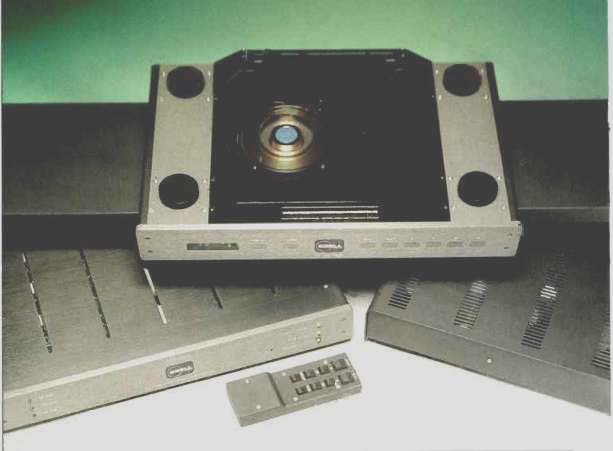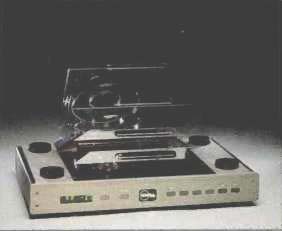

Krell company address: 20 Higgins Dr., Milford, Conn. 06460.
Every high-end audiophile who has had extensive experience with both Compact Discs and analog records has dreamed of finding some way of getting the best features of digital and analog from a single system. There has never been any real prospect analog could provide the flat frequency response, separation, and freedom from noise and distortion that digital provides, but the advances in CD players over the last two years have shown there is a growing prospect that the advantages of digital can be combined with the musically sweet upper octaves, correct musical harmonic structure, transient response, and natural soundstage, depth, and imaging found in the best analog systems.
While mainstream manufacturers have attempted to find affordable solutions to recognized problems in the first several generations of CD players, high-end manufacturers have sought to build the combination of CD deck and digital decoder that would provide the best features of analog and digital.
Some high-end firms have made astounding progress towards this goal in the last year, but the Krell MD-1 CD deck and SBP-64X digital signal processor may well be the first high-end combination that can claim to have truly succeeded.
Like all Krell gear, the MD-1 and SBP-64X are superbly built and styled.
Their appearance and construction are state of the art, as is their sound quality-although excellence is something that might be expected in a transport that costs $5,400 and a decoder that costs $8,950. These are luxury prices even for the high end.
The Krell MD-1 CD transport is built on the Philips CDM-3 transport, with a single-beam laser and glass lens; this mechanism is extremely reliable and is normally used for CD-ROM applications. It is a top-loading mechanism that uses a heavy die-cast chassis mounted on a subframe machined from solid blocks of aluminum. The MD-1 is by far the heaviest and most rigid CD deck mechanism I've encountered, and it is isolated from outside mechanical interference by four suspension towers that hold the substructure. These towers are adjustable to allow precise leveling and coupling to any surface. There is a large, separate power supply in addition.
The SBP-64X digital signal processor is the equivalent of a minicomputer. It uses proprietary, upgradable software to allow four Motorola DSP-56001 processors to perform the equivalent of 64-times oversampling. The SPB-64X is run at a clock speed of over 28 MHz, and uses two Burr-Brown PCM-64 18-bit D/A converters. Unlike most competing processors, the SBP-64X runs parallel data through the DSP-56001 s and into the D/A converters. This allows the unit to run at the extreme speeds needed for 64-times oversampling without multiplexing and then summing the data.
No steep slope or brick-wall filtering is used in the SBP-64X, and current-to-voltage conversion is performed in the analog domain, directly after the D/A converter. Krell believes that doing this in the converter or after using an opamp-the way it's done in virtually all other digital signal processing systems-produces an unacceptable loss of sound quality.
The analog stages are the high-bias Class-A designs that have made Krell one of a handful of world-class high-end preamp and amp manufacturers.
A separate power-supply unit holds three completely independent power supplies and 10 cascaded discrete regulators to provide the five different voltages needed by the SBP-64X. The unit has optical and coaxial digital inputs, and both balanced outputs with XLR jacks and unbalanced, phono-jack outputs.
What really counts about the MD-1 CD deck and SBP-64X, however, is their sound, and this sound is superb with all digital media I have tried: CD, DAT, and satellite. Even when the Krell deck and processor are compared to top competing decoders, DAT decks with advanced digital technology, and state-of-the-art bitstream CD decks, the Krells provide a degree of smooth musicality that has to be heard to be believed.
Adjectives can usually only hint at the musical subtleties that such units can reveal in a true high-end system.
The sonic advantages of the MD-1 CD deck and SBP-64X processor are readily apparent, however. One quick way to demonstrate their superiority is to play older CDs, particularly ones that are slightly hard or edgy on most other players. The Krells cannot make the CD produce sound it doesn't already have, but they do generally make the sound of poor or mediocre CDs more listenable-at least when the problem is not in the CD's miking or production values.
Similarly, no player I have heard does quite so well with AAD recordings. Many great analog recordings have not fared well in their transformation to a digital format. In case after case, the Krell MD-1 CD deck and SBP-64X processor restore most of the ambience and depth of the original and take most of the graininess out of the upper octaves. The soundstage opens up and is less forward, and the power of the bass comes through.
The true merit of the Krell MD-1 and SBP-64X shines forth, however, when they are used to reproduce the latest and best all-digital (DDD) recordings.
The upper midrange and treble have a natural smoothness that causes remarkably little listening fatigue. The Krells reproduce massed strings, piano dynamics, and complex choral and organ music with less congestion and hardness than any CD system I have heard. At the same time, the Krells provide a more natural timbre, a consistency in pitch, and a lack of noise that no consumer-level analog turntable or tape recorder can compete with.
The Krells also deliver a degree of low bass, mid-bass, and upper bass/ lower midrange detail and power that no other CD units I know of can match, either in low bass test-tone comparisons or in music. This adds to the best recordings a degree of natural emotion and warmth that you may have missed until you have heard the MD-1 and SBP-64X. The soundstage is both superior to and strikingly different from that of most digital systems. Mediocre digital systems tend to collapse the sound-stage, remove depth, and blur the imaging. Most superior digital systems--relatively speaking--expand the soundstage and restore depth but have a "forward" apparent listening position, and they add what often appears to be a slightly unnatural amount of upper octave detail and energy. In recent bitstream players, there has also been a tendency to focus the imaging in the center and provide sound-stage detail from the upper six octaves while losing a bit of lower octave reverberation and energy.
The MD-1 and SBP-64X tend to have an apparent mid-hall listening position.
They do not emphasize upper octave detail, and they do an excellent job of reproducing soundstage detail in all octaves. Anyone familiar with the Dorian recordings at Troy Savings Bank Music Hall will find the difference between the Krells and the competition to be particularly striking, as will fans of the organ, Romantic orchestral music, opera, chamber music using older instruments, and naturally recorded acoustic jazz.
Anyone familiar with the digital and analog versions of the Proprius recording Jazz at the Pawnshop should listen to the CD version on the Krell MD-1 and SBP-64X. Compare the Krells' reproduction of the bass line and feeling of space with those heard through competing high-end digital equipment, or with their sound on the LP version on a top-quality turntable. The sound of the Krells is not analog, but it comes remarkably close while still providing all the advantages of CD. In short, when it comes to providing the best sound features of both digital and analog, the MD-1 and SBP-64X not only make the impossible seem possible, they make the end result seem rich and musically natural. However, it is only the subtleties in the way they reproduce music--not my words--that can ultimately persuade you of the merits of the Krell MD-1 and SBP-64X.
--Anthony H. Cordesman
(Source: Audio magazine, June 1991)
Also see:
Krell PAM-3 Preamp and KSA-50 Power Amp (Dec. 1985)
Esoteric P-2 CD Transport and D-2 D/A Converter (Sept. 1991)
= = = =